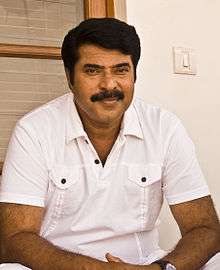New generation (Malayalam film movement)
New generation films widely known as New-Gen cinema (2011–present[1]) is a Malayalam film movement developed in the early 2010s, characterized by fresh and unusual themes and new narrative techniques.[1][2] Films of the new wave differ from conventional themes of the past two decades (1990s and 2000s) and introduced several new trends to the Malayalam industry.[3] While the new generation formats and styles are deeply influenced by global and Indian trends, their thematics are firmly rooted in Malayalee life and mindscapes.[4]
The new generation also helped to revive the Malayalam film industry in the early 2010s.[5] New generation film producers like Listin Stephen who produced Traffic, Sadanandan Rangorath who produced Salt N' Pepper, Sandra Thomas who produced Friday are the producers who believed in this concept and took the initiative to make this movement in the industry.
Characteristics of films
Erosion of the so-called "superstar" system in popular Malayalam films coincided with rise of the new wave where screenplay got rooted-to-reality, closer-to-life and lead characters became ordinary men and women. Influx of new actors, the absence of superstars, rise of metro-centric/urban and middle-class themes and different story-lines were also noted in the wave. While formats and styles of the new directors are deeply influenced by the global and Indian trends, their thematics were firmly rooted in Malayali life and mind-scape.[6] A recurrent trope in these new narratives is accidents, coincidences, casual encounters and chance meetings that set in motion an unexpected chain of events affecting the lives of the characters drifting in the urban flotsam.[6] The frequent use of Malayalam influenced by English is also noted in the films.[7]
Until recently, most Malayalam films had rural themes portraying the "essential goodness" and "unspoilt beauty" of villages.[8] The focus of the films also shifted from the conventional masculine, handsome, virtuous and invincible hero to more humane characters. Another notable feature is that stories shifted to depict more non-male characters as lead. Movies featuring gender minorites and homosexual leads is definitive characteristic of this era of Malayalam cinema. [2] Actors such as Thilakan (Ustad Hotel) and Prathap Pothen (Ayalum Njanum Thammil) were noted for their hard-hitting performances in the Wave films.[3] The depiction of women has also changed in the New Wave films beyond recognition. A number of female-oriented films such as 22 Female Kottayam, Cocktail, Beautiful and Trivandrum Lodge were also part of the new wave.[1] The leading ladies often flirt openly, drink in public, and make lewd comments.[2] The new wave films are criticized for explicit language and provocative themes, often under the guise of bold or modern.[3]
Impact on superstars
The new wave soon ignited a debate about the era of superstars coming to an end and Malayalam cinema witnessing a radical change.[9] In the 1980s, stars mattered, though not as much as in the 1990s and 2000s, when Malayalam cinema was practically dictated by the then superstars of the industry.[10] The stranglehold of superstars that was stifling any new experimentation, complemented by the autocratic control of Malayalam film industry organisations over all areas of the industry was seen as pushing the industry to the wall.[6]
As per critics, the new wave of activity in Malayalam cinema is reminiscent of the 1980s, regarded as the golden age of Malayalam cinema, when mainstream films bridged the gap between arthouse and commercial movies, led by a team of talented writers and directors.[10] In the 1980s, Malayalam films witnessed some positive changes through directors like Padmarajan and Bharathan, who made path-breaking films. These films too broke the norms which were considered the prerequisite for a commercial entertainer, and traversed a new path between popular and parallel cinema.[9]
Most of the new wave films are modestly budgeted, thus supporting experiments by new directors, between Rs. 2 and 30 million each (compared to the average Malayalam commercial film budget of Rs. 6 – 80 million) and have more than recovered their investment.[2][7]
Characteristics of film-makers
A few young writers and directors successfully brought in the New Wave with films such as Traffic, Salt N' Pepper, Chappa Kurishu, Beautiful and Neram. Fields such as acting, cinematography, editing, scripting and music also witnessed the emergence of new talent. Still, the conventional patterns have refused to give way and continue to have a strong support base among viewers.[6][11]
 Nivin Pauly
Nivin Pauly Dulquer Salmaan
Dulquer Salmaan Vineeth Sreenivasan
Vineeth Sreenivasan Jayasurya
Jayasurya
Unlike the general trend in the Malayalam films, most of the New Generation directors are young.[1] Director Aashiq Abu, one of the most promising film-makers in Malayalam, directed several New Wave films to box-office success.[3] Actor-producer Jayasurya who had debuted into the industry in 2002, had begun creating a benchmark in the new-wave of cinema through phenomenal acting performances in films such as Cocktail. Beautiful and Trivandrum Lodge. Jayasurya had also broke the image barrier of performing in lead roles for a mainstream actor or star, by essaying several character roles and antagonist roles all which were critically acclaimed.[12] Actor-writer Anoop Menon is another emerging personality in the New Generation field.[3][10] Actors like Prathap Pothen and Tini Tom are also earning newfound appeal among the Malayali audiences.[10] Other prominent New Wave actors include Nivin Pauly, Dulquer Salmaan, Fahadh Faasil, Thilakan, Murali Gopy, Rima Kallingal, Ann Augustine, Remya Nambeesan, Maithili and Honey Rose. Cinematographers like Jomon T. John, Shyju Khalid, Pradeep Nair, Madhu Neelakantan, Shehnad Jalal and Amal Neerad, and editors like Don Max, Vivek Harshan, Ajitkumar and Mahesh Narayan gave their films a slick contemporariness.[6][13]
New generation directors
- Alphonse Putharen
- Rajesh Pillai
- Lijo Jose Pellissery
- Aashiq Abu
- Geethu Mohandass
- Altas T. Ali
- Sameer Thahir
- V. K. Prakash
- Lijin Jose
- Sankar
- Anwar Rasheed
- Roopesh Peethambaran
- Lal Jose
- Arun Kumar Aravind
- Amal Neerad
- Shalini Usha Nair
- Sidharth Bharathan
- Shyju Khalid
- Vineeth Sreenivasan
- Rajeev Ravi
- Aji John
- Anjali Menon
- Gireesh
- Vinay Govind
- Vipin Vijay
- Sherry
- Salim Ahmed
- Madhupal
- Madhav Ramdas
- Joy Mathew
- Khalid Rahman
- K B Venu
- Jayan Cherian
- Arjun M
A few films widely regarded as 'New-Gen'
- Traffic[11] – a film that was directed by Rajesh Pillai and now widely regarded as one of the movies that gave New Generation Cinema the green signal.[14]
- City of God[15]
- Salt N' Pepper[11]
- Chappa Kurishu[11]
- Beautiful[11]
- Friday[3]
- 22 Female Kottayam[3]
- Second Show[3]
- Ustad Hotel[3]
- Theevram[3]
- Ayalum Njanum Thammil[3]
- Ee Adutha Kaalathu[2]
- Akam[2]
- Nidra[2]
- Da Thadiya[2]
- Cocktail[2]
- Trivandrum Lodge[16]
- 5 Sundarikal[1]
- Thattathin Marayathu[6]
- Annayum Rasoolum[6]
- Amen[7]
- Hotel California[7]
- Nee Ko Njaa Cha[7]
- Kili Poyi[7]
- Neelakasham Pachakadal Chuvanna Bhoomi[17]
- Mumbai Police
- Bangalore Days
- 1983
- 1 by Two
- Double Barrel
- Premam
- Neram
- Maheshinte Prathikaaram
- Kumbalangi Nights
- Unda
General response and criticisms
There is a general consensus that The New-Gen movies draw a lot of inspiration other film industries. They depict lives of people living in 21st century Kerala through a very realistic lens, it's often said that most of its success is due to the freshness these narratives possess in comparison to traditional Malayalam movies. . New-Gen Malayalam movies tend to feature more nucleus families rather than the traditional joint families. This has reduced characters such as grand parents, uncles, aunts etc. This and the adult themes present in a lot of movies has gained the New-Gen movies the criticism that they're primary targeted towards young people.
The use of latest technology has added speed to the process of change in the industry. More advanced technology and innovative techniques are being experimented. The industry has become more open to trying out new ideas.
Malayalam actor Jayaram has talked about his disinterest towards the new generation films publicly, he has heard to be saying the new wave films lacks its appeal towards a family environment as the inappropriateness of mannerisms in certain films, beyond a PG-13 is very awkward to someone who expects to watch a family film such as most of the conventional Malayalam movies were, which did not need a specific rating.
The New generation received criticism from some conventional film-makers like Dilshad. They accused that plagiarized versions of foreign films are being presented under the guise of New Wave experiments.[3] While admirers of the New Wave of Malayalam films call it the "Jasmine revolution", critics refer it as the "multiplex revolution".[2]
"Some films that are fresh in thought and execution have clicked at the box office," says veteran director Sibi Malayil. "But I am against referring to them as New Wave Cinema. Changes were always there in Malayalam films. But most of these so-called new-generation movies revolve around the themes that deal with life in a metro city. These films are getting a good response in tier-I cities only".[9]
References
- Malayalam new generation films failing to click? – Indian Express
- "Malayalam cinema pushes the envelope : NATION – India Today". Indiatoday.intoday.in. 7 July 2012. Retrieved 25 January 2013.
- Vijay George (27 December 2012). "Arts / Cinema : The show goes on…". Chennai, India: The Hindu. Retrieved 25 January 2013.
- http://www.frontline.in/arts-and-culture/cinema/new-trails-of-discovery/article5189455.ece?homepage=true
- City Times – Hit parade
- Venkiteswaran, C. S. (13 April 2013). "Goodbye to the superstar era". The Hindu. Chennai, India.
- www.outlookindia.com | Chemmeen Pickle
- "Malayalam movies turn urban-centric | NDTV Movies.com". Movies.ndtv.com. 6 June 2012. Retrieved 24 March 2013.
- "Malayalam cinema still considers old as gold". Ibnlive.in.com. 23 September 2012. Retrieved 24 March 2013.
- "CityTimes – Glorious 100". Khaleejtimes.com. 4 November 2012. Retrieved 24 March 2013.
- Vijay George (12 April 2012). "Arts / Cinema : Battle of the genres". Chennai, India: The Hindu. Retrieved 25 January 2013.
- http://www.indiaglitz.com/jayasurya-to-bounce-back-malayalam-news-99303
- http://www.khaleejtimes.com/citytimes/inside.asp?section=citytimes&xfile=/data/citytimes/2012/November/citytimes_November40.xml,
- Sathyendran, Nita (3 July 2013). "Shot at direction". The Hindu. Chennai, India.
- Nair, Manoj. "Malayalam movies: Non-linear narratives are making the box-office ring louder – The Economic Times". The Times of India.
- Meena T. Pillai (7 March 2013). "The daughters of P.K. Rosy". Chennai, India: The Hindu. Retrieved 24 March 2013.
- Review: Neelakasham Pachakkadal Chuvanna Bhoomi is impressive – Rediff.com Movies

